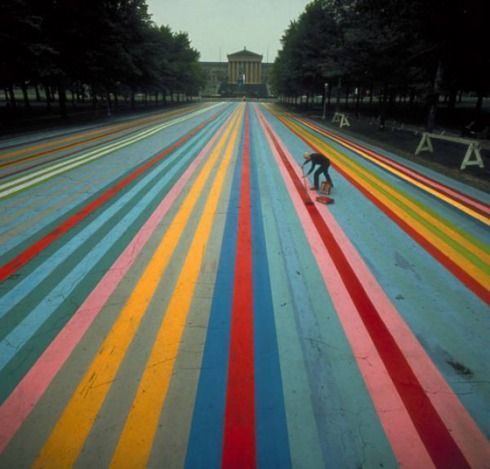 | ||
A visual-art movement of the late 1950s through the late-1960s centered in Washington, D.C., the Washington Color School describes a form of abstract art that developed from color field painting, itself a form of abstract art that explored ways to use large solid areas of paint, as exemplified by the work of Mark Rothko and Helen Frankenthaler. The Washington Color School originally consisted of a group of painters who showed works in an exhibit called the "Washington Color Painters" at the now-defunct Washington Gallery of Modern Art in Washington from June 25 to September 5, 1965. This exhibition, which subsequently traveled to several other venues in the United States, including the Walker Art Center, solidified Washington's place in the national movement and defined what is considered the city's signature art movement. The exhibition's organizer was Gerald "Gerry" Nordland and the painters included Gene Davis, Morris Louis, Kenneth Noland, Howard Mehring, Hilda Thorpe, Thomas "Tom" Downing, and Paul Reed.

The Washington Color School artists painted largely abstract works, and were central to the larger color field movement. Though not generally considered abstract expressionists, insofar as much of their work is more orderly than—and not apparently motivated by—the philosophy behind—abstract expressionism, there are parallels between the Washington Color School and the abstract expressionists largely to their north in New York City. Minimally, the use of stripes, washes, and fields of single colors of paint on canvas were common to most artists in both groups.

After their initial, benchmark exhibition, Davis, Mehring, Downing, and Reed exhibited at various times at Jefferson Place Gallery, which was originally directed by Alice Denney and later owned and directed by Nesta Dorrance. Other artists associated with the group include Sam Gilliam, Anne Truitt, Mary Pinchot Meyer, Leon Berkowitz, Jacob Kainen Alma Thomas, and James Hilleary, among others. The group is sometimes thought to have expanded as it achieved a dominant presence in the Washington, D.C. visual art community through the 1960s and into the 1970s. Along with the original Washington Color School painters, a second generation also exhibited at Jefferson Place Gallery. The movement remained influential even as some of its members dispersed elsewhere.

Artists

Hilda Thorpe (Hilda Shapiro Thorpe) was a color field painter who made oversized paintings and paper sculpture and who taught a generation of metro Washington, D.C. artists. Other Washington Color School female artists include Anne Truitt, whose work relates to the 'minimalist-purity' side of three-dimensional painterly objects and painters, Mary Pinchot Meyer, and Alma Thomas. Other works reflecting the ethos of the Washington Color School include Sam Gilliam's suspended paintings (by contrast they are almost baroque in sensibility), Rockne Krebs' transparent sculptures, light and laser works, Ed McGowin's vacuum-formed pieces which he was ending and moving towards a more personal art (tableau), Bill Christenberry's neon works, which led him to deal more directly with his roots, and the work of Bob Stackhouse and Tom Green.
During spring and summer 2007, arts institutions in Washington, D.C. staged a citywide celebration of color field painting, including exhibitions at galleries and museums of works by members of the Washington Color School. In 2011, a group of Washington art collectors began the Washington Color School Project, to gather and publish information about the history of the color painters and abstract art in Washington. The Washington Color School wasn't a physical building itself but a movement starting in Washington DC, built of six core abstract expressionist artists during the 1950s–1970s. They emerged during a time where society, the arts and people were changing quickly. The inner circle of this new visual art movement consisted of six artists who later became known as the Washington color-field artists a.k.a. the Washington Color School, Kenneth Noland, Morris Louis, Gene Davis, Howard Mehring, Tom Downing, and Paul Reed. Though some of them were not born in Washington, they exhibited together representing Washington as a new hub for the visual arts.
